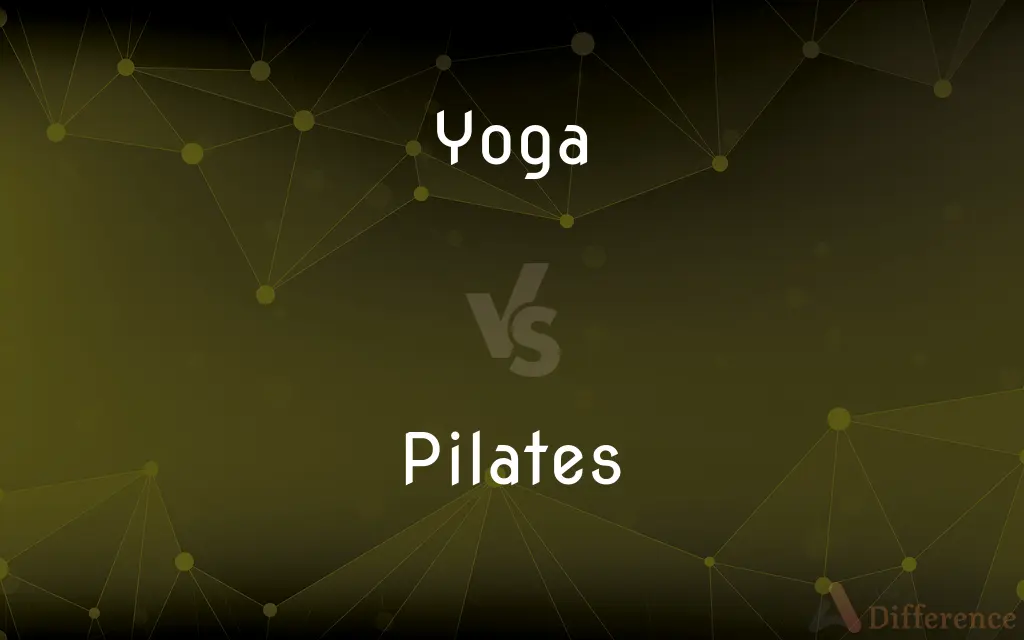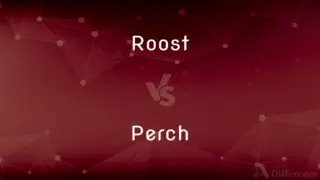Yoga vs. Pilates — What's the Difference?
By Urooj Arif & Maham Liaqat — Updated on March 24, 2024
Yoga focuses on flexibility, balance, and relaxation through various postures and breathing techniques, while Pilates emphasizes core strength, posture, and muscle tone.

Difference Between Yoga and Pilates
Table of Contents
ADVERTISEMENT
Key Differences
Yoga is an ancient practice that originated in India, emphasizing physical, mental, and spiritual wellness. It incorporates various postures (asanas), meditation, and breathing exercises (pranayama) to enhance flexibility, reduce stress, and improve overall health. Pilates, on the other hand, was developed in the early 20th century by Joseph Pilates as a form of exercise to strengthen the core, improve posture, and increase muscle tone and flexibility.
While yoga sessions can vary from gentle and meditative to physically demanding, they always aim to promote a deep sense of inner peace and connection between the mind, body, and spirit. Pilates focuses more on physical conditioning, employing precise movements and breath control to build strength from the body's core while also enhancing flexibility and joint mobility.
Yoga practices include a wide range of styles, such as Hatha, Vinyasa, and Ashtanga, each offering different intensities and focuses but all aiming to harmonize the body and mind. Pilates also has variations, including mat exercises and apparatus-based workouts like the Reformer, which provide resistance and support to the exercises, targeting specific muscle groups.
In terms of benefits, yoga is renowned for its ability to improve flexibility, reduce stress, and contribute to emotional and mental well-being through its meditative aspects. Pilates is highly regarded for its effectiveness in rehabilitating injuries, improving posture, and offering a strong foundation for athletic performance by focusing on core strength, alignment, and muscle balance.
The spiritual component is a significant aspect where yoga and Pilates diverge; yoga often incorporates spiritual elements and practices aimed at achieving a state of enlightenment or personal growth. Pilates, while it emphasizes the connection between the mind and body, is generally more focused on physical improvement and does not include a spiritual practice.
ADVERTISEMENT
Comparison Chart
Origin
Ancient India, focusing on holistic well-being.
Early 20th century, created by Joseph Pilates.
Key Focus
Flexibility, balance, breathing, and spirituality.
Core strength, posture, muscle tone.
Styles/Variations
Hatha, Vinyasa, Ashtanga, and more.
Mat Pilates, Reformer Pilates, and other apparatus-based exercises.
Physical Benefits
Improves flexibility, reduces stress, enhances mental health.
Strengthens core, improves posture, increases muscle tone.
Mental/Spiritual Aspects
Promotes inner peace, mindfulness, and spiritual growth.
Focuses on mind-body connection, less emphasis on spirituality.
Equipment
Minimal, may include mats, blocks, and straps.
Uses specialized equipment like Reformers, mats, and balls.
Accessibility
Can be practiced anywhere, suitable for all ages and levels.
Accessible but may require equipment or studio classes for full benefits.
Emphasis
Balancing the mind, body, and spirit.
Improving physical strength and flexibility.
Compare with Definitions
Yoga
Emphasizes flexibility and mental well-being.
Regular yoga practice can significantly increase flexibility and reduce stress levels.
Pilates
Focuses on core strength, posture, and flexibility through precise movements.
Pilates classes often include exercises that target the abdominal muscles for core strengthening.
Yoga
Can be practiced with minimal equipment.
All you need for yoga is a mat, though some opt for blocks or straps to assist in certain poses.
Pilates
Known for improving muscle tone and posture.
Regular Pilates practice can lead to noticeable improvements in posture and muscle definition.
Yoga
A holistic practice combining physical postures, meditation, and breathing exercises.
Yoga classes often end with a relaxation pose to integrate the practice's physical and mental benefits.
Pilates
Suitable for rehabilitation and injury prevention.
Pilates is often recommended for individuals recovering from injuries, thanks to its focus on controlled movements.
Yoga
Offers various styles to suit individual preferences.
Vinyasa yoga is popular for its dynamic flow from one posture to another.
Pilates
Utilizes specialized equipment for resistance.
The Reformer, a popular Pilates apparatus, adds resistance to exercises, enhancing their effectiveness.
Yoga
Integrates spiritual elements into the practice.
Many yoga sessions include chanting or meditation for spiritual well-being.
Pilates
Lacks the spiritual aspect of yoga, focusing more on the physical.
While Pilates improves the mind-body connection, it does not explore spiritual practices.
Yoga
Yoga (; Sanskrit: योग; ISO: Yōga , pronunciation), Sanskrit for "yoking" or "union", is a group of physical, mental, and spiritual practices or disciplines that originated in ancient India. Yoga is one of the six orthodox philosophical schools of Hinduism.
Pilates
Pilates (; German: [piˈlaːtəs]) is a physical fitness system developed in the early 20th century by Joseph Pilates, after whom it was named. Pilates called his method "Contrology".
Yoga
Also Yoga An ascetic Hindu discipline involving controlled breathing, prescribed body positions, and meditation, with the goal of attaining a state of deep spiritual insight and tranquility.
Pilates
A system of exercises that promote the strengthening of the body, often using specialized equipment.
Yoga
A system of stretching and positional exercises derived from this discipline to promote good health, fitness, and control of the mind.
Pilates
Alternative case form of Pilates
Yoga
Any of several Hindu or Buddhist disciplines aimed at training the consciousness for a state of perfect spiritual insight and tranquillity; especially a system of exercises practiced to promote control of the body and mind.
Yoga
The tree Elaeocarpus joga.
Yoga
A species of asceticism among the Hindoos, which consists in a complete abstraction from all worldly objects, by which the votary expects to obtain union with the universal spirit, and to acquire superhuman faculties.
Yoga
Hindu discipline aimed at training the consciousness for a state of perfect spiritual insight and tranquility that is achieved through the three paths of actions and knowledge and devotion
Yoga
A system of exercises practiced as part of the Hindu discipline to promote control of the body and mind
Common Curiosities
What is Pilates?
Pilates is an exercise system designed to improve physical strength, flexibility, posture, and mental awareness.
Is Pilates good for injury recovery?
Yes, Pilates is often recommended for rehabilitation due to its focus on controlled, precise movements and core strengthening.
What is yoga?
Yoga is a comprehensive practice that includes physical postures, breathing exercises, and meditation to enhance overall well-being.
How do yoga and Pilates differ in focus?
Yoga focuses on flexibility, balance, and spirituality, while Pilates centers on core strength, posture, and muscle tone.
Do I need special equipment for yoga or Pilates?
Yoga can be practiced with just a mat, but Pilates often involves specialized equipment, especially in studio settings.
Can yoga or Pilates help with stress?
Yes, both can help reduce stress, but yoga is particularly noted for its meditative and relaxation techniques.
Are Pilates and yoga suitable for beginners?
Both are suitable for beginners, but it's important to start with classes or instructions geared towards your fitness level.
Can yoga or Pilates help with weight loss?
Both can be part of a weight loss regimen, though they are more focused on toning, flexibility, and mental well-being than rapid weight loss.
Which is better for building muscle, yoga or Pilates?
Pilates is generally better for building muscle, especially core muscles, due to its focus on resistance and strength training.
Do I need to be flexible to start yoga?
No, you do not need to be flexible to start yoga; flexibility is a benefit that comes with regular practice.
Which is better for improving flexibility, yoga or Pilates?
Yoga is typically better for enhancing flexibility due to its wide range of stretches and postures.
Is there a spiritual aspect to Pilates?
Unlike yoga, Pilates does not have a spiritual aspect and focuses more on the physical connection between mind and body.
How often should I practice yoga or Pilates?
Frequency can vary based on personal goals and schedules, but many benefit from practicing 2-4 times per week.
Share Your Discovery

Previous Comparison
Roost vs. Perch
Next Comparison
Lightly vs. SparinglyAuthor Spotlight
Written by
Urooj ArifUrooj is a skilled content writer at Ask Difference, known for her exceptional ability to simplify complex topics into engaging and informative content. With a passion for research and a flair for clear, concise writing, she consistently delivers articles that resonate with our diverse audience.
Co-written by
Maham Liaqat














































